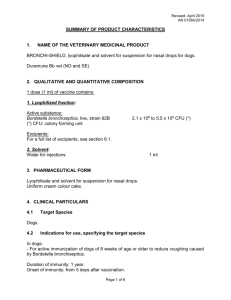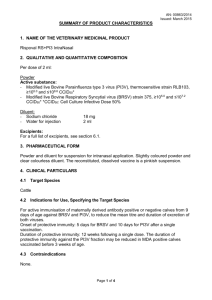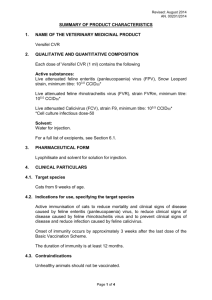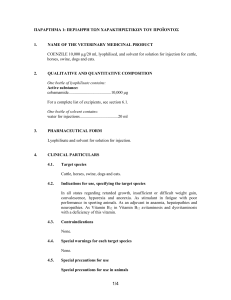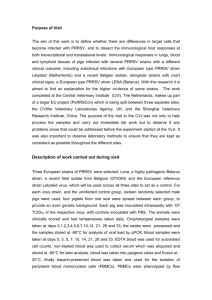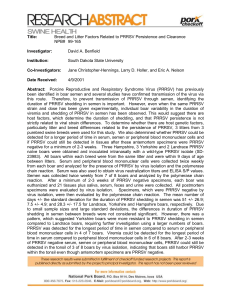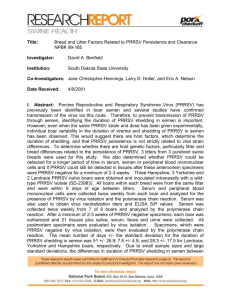Revised: September 2015 AN: 00501/2015 SUMMARY OF
advertisement
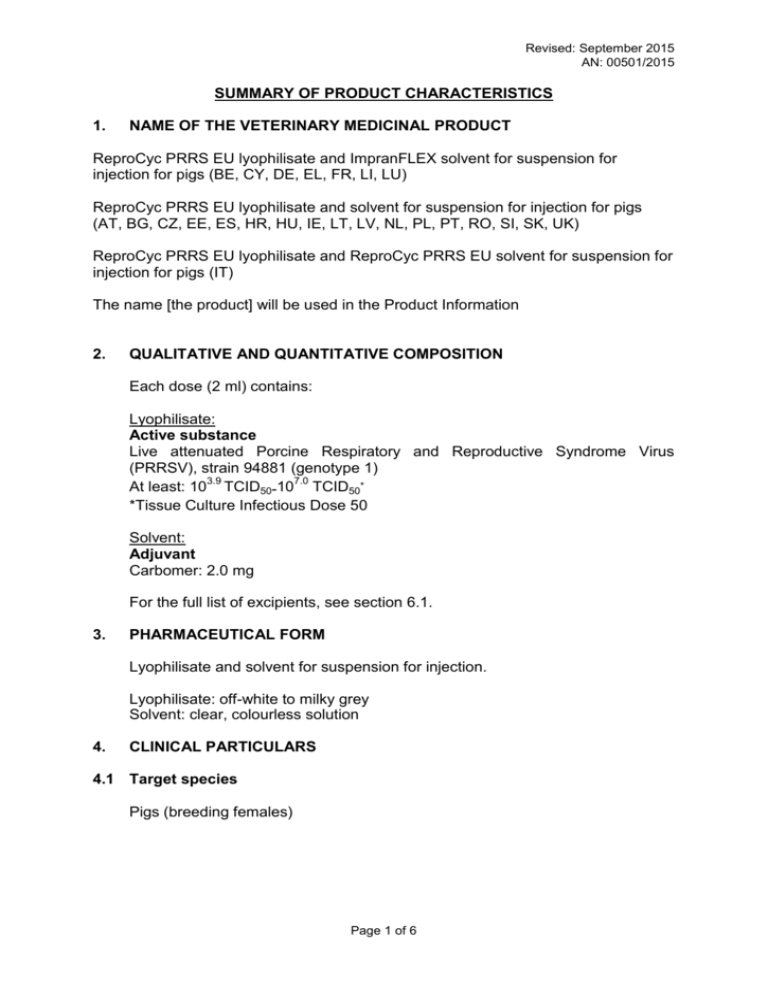
Revised: September 2015 AN: 00501/2015 SUMMARY OF PRODUCT CHARACTERISTICS 1. NAME OF THE VETERINARY MEDICINAL PRODUCT ReproCyc PRRS EU lyophilisate and ImpranFLEX solvent for suspension for injection for pigs (BE, CY, DE, EL, FR, LI, LU) ReproCyc PRRS EU lyophilisate and solvent for suspension for injection for pigs (AT, BG, CZ, EE, ES, HR, HU, IE, LT, LV, NL, PL, PT, RO, SI, SK, UK) ReproCyc PRRS EU lyophilisate and ReproCyc PRRS EU solvent for suspension for injection for pigs (IT) The name [the product] will be used in the Product Information 2. QUALITATIVE AND QUANTITATIVE COMPOSITION Each dose (2 ml) contains: Lyophilisate: Active substance Live attenuated Porcine Respiratory and Reproductive Syndrome Virus (PRRSV), strain 94881 (genotype 1) At least: 103.9 TCID50-107.0 TCID50* *Tissue Culture Infectious Dose 50 Solvent: Adjuvant Carbomer: 2.0 mg For the full list of excipients, see section 6.1. 3. PHARMACEUTICAL FORM Lyophilisate and solvent for suspension for injection. Lyophilisate: off-white to milky grey Solvent: clear, colourless solution 4. CLINICAL PARTICULARS 4.1 Target species Pigs (breeding females) Page 1 of 6 Revised: September 2015 AN: 00501/2015 4.2 Indications for use, specifying the target species For active immunisation of breeding females from farms affected with European (genotype 1) Porcine Reproductive and Respiratory Syndrome Virus (PRRSV) to reduce the duration of viraemia, the proportion of viraemic gilts/sows and viral loads in blood after exposure to PRRSV as shown under experimental conditions. Onset of immunity:5 weeks Duration of immunity: 17 weeks Vaccination of breeding females according to the recommended schedule described in section 4.9 reduces the negative reproductive disorders associated with PRRSV. Under experimental challenge conditions a reduction in transplacental virus transmission after challenge was additionally demonstrated. In piglets from vaccinated sows, a reduction in the negative impact of PRRS virus infection (mortality, clinical signs and weight gain) was also demonstrated during the first 20 days of life. 4.3 Contraindications Do not use in case of hypersensitivity to the active substance or to any of the excipients. Do not use in boars producing semen for naïve herds, as PRRSV can be shed in semen. Do not use in PRRS naïve herds in which the presence of PRRSV has not been established using reliable diagnostic methods. 4.4 Special warnings for each target species Precautions should be taken to avoid the transfer of the vaccine virus within the herd, e.g. from positive animals to naïve animals. 4.5 Special precautions for use Special precautions for use in animals Vaccinate only clinically healthy animals. The vaccine strain may spread up to 5 weeks after vaccination to unvaccinated animals in contact but without any clinical consequence. Vaccinated animals may excrete the vaccine strain by faecal excretion. The potential excretion of the vaccine strain in the urine of vaccinated animals has not been investigated. The vaccine strain has been detected in new-born piglets (blood, lung samples) when vaccinating naïve gilts during last third of gestation but without any clinical consequence. Care should be taken to avoid spread of vaccine virus from vaccinated animals to unvaccinated animals that should remain free from PRRSV. Page 2 of 6 Revised: September 2015 AN: 00501/2015 It is advised to vaccinate all breeding females within a herd. Newly introduced PRRSV-naïve females (e.g. replacement females from PRRSV-negative herds) should be vaccinated prior to pregnancy. For optimal PRRSV control programme, all animals in a herd should be vaccinated. Special precautions to be taken by the person administering the veterinary medicinal product to animals In case adverse reactions develop following accidental self-injection, seek medical advice and show the package leaflet or the label to the physician. 4.6 Adverse reactions (frequency and seriousness) A transient increase in body temperature (up to 2°C above the physiological range) commonly occurs up to 5 days post-vaccination. Temperatures return to the normal range without additional treatment, 1 to 4 days after the maximum temperature increase is observed. Commonly, reduced appetite may be observed after vaccination. Uncommonly, recumbency and accelerated breathing can be observed on the day of vaccination. These signs disappear spontaneously without any treatment. Commonly, very minimal swelling or redness of the skin at the injection site may be observed. These reactions (up to 8cm but typically < 2 cm in size) are transient and subside within a short time (maximum of 5 days but typically less than 2 days) without treatment. The frequency of adverse reactions is defined using the following convention: - very common (more than 1 in 10 animals displaying adverse reactions during the course of one treatment) - common (more than 1 but less than 10 animals in 100 animals) - uncommon (more than 1 but less than 10 animals in 1,000 animals) - rare (more than 1 but less than 10 animals in 10,000 animals) - very rare (less than 1 animal in 10,000 animals, including isolated reports). 4.7 Use during pregnancy, lactation and lay Can be used during pregnancy and lactation. PRRSV naïve gilts should not be vaccinated during pregnancy. 4.8 Interaction with other medicinal products and other forms of interaction No information is available on the safety and efficacy of this vaccine when used with any other veterinary medicinal product. A decision to use this vaccine before or after any other veterinary medicinal product therefore needs to be made on a case by case basis. Page 3 of 6 Revised: September 2015 AN: 00501/2015 4.9 Amounts to be administered and administration route Dosage and method of administration: Single intramuscular injection of one dose (2 ml), irrespective of body weight. For reconstitution, transfer the entire content of the solvent vial to the vial containing the lyophilisate and reconstitute the lyophilisate as follows: 10 doses in 20 ml, 50 doses in 100 ml and 100 doses in 200 ml of the solvent. Ensure that the lyophilisate is completely reconstituted before use. Avoid introduction of contamination during use. Use sterile equipment. Avoid multiple broaching, for example by using automatic injectors. Regime of vaccination: Gilts: for protection against PRRSV during pregnancy vaccination is recommended before integration into the sow herd between 2 and 5 weeks prior to breeding. Gilts can then be subjected to the same vaccination programme as the sow herd. Sows: mass vaccination is recommended in a whole herd programme, in which all the pregnant and non-pregnant sows in the herd are vaccinated every three to four months. 4.10 Overdose (symptoms, emergency procedures, antidotes), if necessary No adverse events other than those listed in section 4.6 for a single dose were observed following a 10-fold overdose administration. 4.11 Withdrawal period Zero days. 5. IMMUNOLOGICAL PROPERTIES Pharmacotherapeutic group: Porcine Reproductive and Respiratory Syndrome Virus ATCvet code: QI09AD03 The vaccine is designed to stimulate the development of an immune response in pigs to Porcine Reproductive and Respiratory Syndrome virus. 6. PHARMACEUTICAL PARTICULARS 6.1 List of excipients Lyophilisate: Sucrose Gelatin Potassium hydroxide Glutamic acid Page 4 of 6 Revised: September 2015 AN: 00501/2015 Potassium dihydrogen phosphate Dipotassium phosphate Sodium chloride Solvent: Phosphate buffered solution: Sodium chloride Potassium chloride Potassium dihydrogen phosphate Disodium hydrogen phosphate Water for injection Carbomer 6.2 Incompatibilities Do not mix with any other veterinary medicinal product except solvent supplied for use with the veterinary medicinal product. 6.3 Shelf life Shelf life of the vaccine lyophilisate as packaged for sale: Shelf life of the solvent as packaged for sale: Shelf life after reconstitution according to directions: 15 months 3 years 4 hours 6.4 Special precautions for storage Store and transport refrigerated (2 °C – 8 C). Do not freeze. Protect from light. 6.5 Nature and composition of immediate packaging Lyophilisate: Type I amber glass vials with bromobutyl rubber stopper and aluminium seal. Solvent: High density polyethylene (HDPE) vials with a bromo- or chlorobutyl rubber stopper and aluminium seal. 1 lyophilisate vial of 20 ml (10 doses), 100 ml (50 doses) or 200 ml (100 doses) and 1 solvent vial of 20 ml, 100 ml or 200 ml packed in one cardboard box. 12 or 25 lyophilisate vials of 20 ml (10 doses), 100 ml (50 doses) or 200 ml (100 doses) packed in a separate cardboard box. 12 or 25 solvent vials of 20 ml, 100 ml or 200 ml packed in a separate cardboard box. Not all package sizes may be marketed. Page 5 of 6 Revised: September 2015 AN: 00501/2015 6.6 Special precautions for the disposal of unused medicinal product or waste materials Any unused veterinary medicinal product or waste materials derived from such veterinary medicinal product should be disposed of in accordance with local requirements. 7. MARKETING AUTHORISATION HOLDER Boehringer Ingelheim Limited Ellesfield Avenue Bracknell Berkshire RG12 8YS 8. MARKETING AUTHORISATION NUMBER Vm 00015/4089 9. DATE OF AUTHORISATION 26 March 2015 10. DATE OF REVISION OF THE TEXT September 2015 Approved: 22 September 2015 Page 6 of 6
